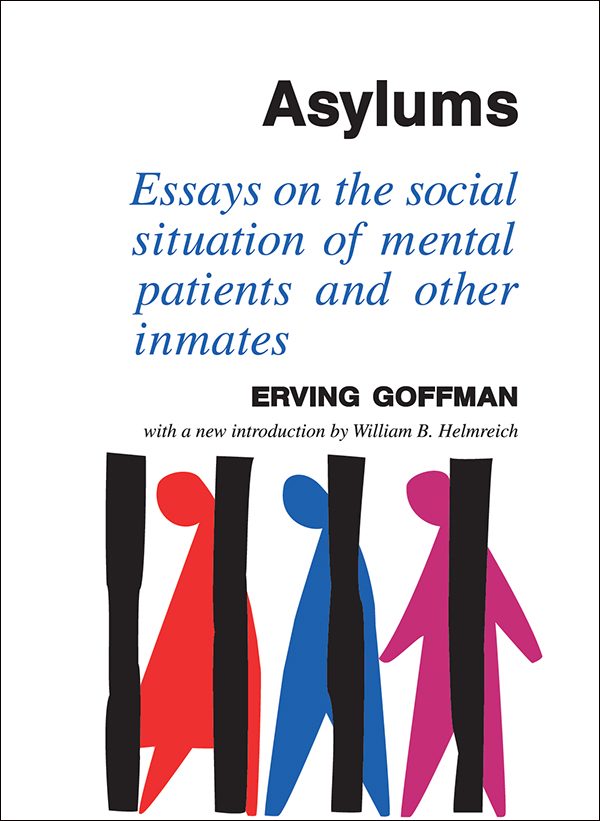Originally published in 1961 by Doubleday & Company, Inc.
New material this edition copyright 2007 by Taylor & Francis.
All rights reserved. No part of this book may be reprinted or reproduced or utilised in any form or by any electronic, mechanical, or other means, now known or hereafter invented, including photocopying and recording, or in any information storage or retrieval system, without permission in writing from the publishers.
Goffman, Erving.
Asylums : essays on the social situatoin of mental patients and other inmates /
Erving Goffman ; with a new introduction by William B. Helmreich.
p. cm.
Originally published: Garden City, N.Y.: Anchor Books, 1961.
Includes bibliographical references (p. ).
ISBN 978-0-202-30971-2 (alk. paper)
1. Psychiatric hospitalsSociological aspects. 2. Mentally ill. I. Title.
The Enduring Significance of Erving Goffman's Work
Erving Goffman was born on June 11, 1922 in Canada and died in Philadelphia on November 19, 1982. A professor of anthropology and sociology at the University of Pennsylvania, he had just completed his term as president of the American Sociological Association. An expert on human interaction, Goffman wrote many books, the most prominent of which were perhaps Asylums, Encounters, Stigma, Behavior in Public Places, Interaction Ritual, and Frame Analysis.
Our focus here is on Asylums. The book is divided into four essays, each designed to stand on its own, even as they are based on Goffman's study of a large, 7,000-patient institution, St. Elizabeth's Hospital in Washington, D.C., in 1955-56. The Laboratory that supported his endeavors was led by the sociologist John Clausen. Other sociologists who worked there included Melvin Kohn, a past American Sociological Association president, William Caudill, Morris Rosenberg, and Leonard Pearlin.
The first essay deals with total institutions, as an ideal type in the Weberian sense and has become a classic on the subject. It is followed by a piece on the moral career of a patient, namely how he/she moves from the status of a pre-patient to that of an in-patient. In the third essay, the author turns his attention to the daily regimen of an institution for the mentally disabled, or, as he puts it, its underlife. The concluding section takes up the medical model of a hospital, especially patient-physician relationships.
Fifty years have passed since Erving Goffman did his field work in St. Elizabeth's and it seems fair to ask: What is the long-term importance of Asylums? What can it teach us about human behavior that we do not already know from other works? Can today's students relate to it? To answer these questions, it is necessary to turn to the book itself.
Although he titled the book, Asylums, even a cursory glance at the first essay reveals extensive references to all types of total institutions, ranging from the military, to convents, to prisons, to boarding schools, and to institutions for the mentally disabled. Goffman understood that there were characteristics common to all of these, but also important distinctions between them. It was his gift to use examples from the literature that were both representative and insightful, whether it was an excerpt from Katherine Hulme's The Nun 's Story, Eugen Kogon's The Theory and Practice of Hell, or Gresham Sykes' The Society of Captives.
By freely acknowledging the limitations of his work, Goffman was able to blunt serious criticism regarding these shortcomings. They are worth noting in any event since they enable us to understand his overall analysis in its proper perspective. Most important perhaps is that when he did his field work he presented himself as an assistant to the athletic director, adding, if questioned closely, that he was also a student of recreation and community life. Management knew what he was doing but he avoided contact with the staff so as to gain the patients' trust. Had Goffman posed as a patient, as some researchers have done in recent years, he might have gained greater insight into their lives, but doing so would also have seriously affected his mobility.
Because he was looking at the patient's social world for the most part, he did not have the input of other crucial actors who significantly affected the patients from their perspectivenamely nurses, physicians, and other staff, except superficially. This deficit is somewhat exacerbated here because the split between staff and patients is more pronounced in a total institution.
In his defense, Goffman observed at the time that almost all prior research had evaluated mental patients from the viewpoint of the medical profession. He also noted, almost parenthetically, that he did not have great respect for the practice of psychiatry and consequently, for their perspective, which he eschewed in his own work. Goffman viewed himself as a structuralist, not a psychologist and he was as critical of psychiatry as were his contemporaries, R.D. Laing and Thomas Szasz. This may, or may not, account for the fact that Goffman never focused to any serious extent on the subject of mental illness. Notwithstanding the acclaim which greeted the publication of Asylums, he pretty much ignored the subject afterwards, both theoretically and empirically. Rather he chose like, Michel Foucault, in Madness and Civilization (1965), to concentrate on social control in its many contexts.
One of the most lasting contributions of Goffman's study is his finding that the patients were not as crazy as commonly thought. This stereotype, in Goffman's view, was largely due to the fact that staff, and certainly outsiders were unfamiliar with patient life and culture. Goffman freely admitted to having the biases of a typical middle class person. Of course, he would have had other biases had he been upper or lower class. The virtue of such admissions is not one of eliminating bias but rather, one of acknowledgingand thereby perhaps lesseningits possible impact on one's work.
In examining the social life of total institutions, Goff-man demonstrates how they strip the individual's former identity and then re-socialize him. This is an example of one of Goffman's trademark contributionshis persistently unique and perceptive insights that sharpen or reshape our understanding of an ostensibly familiar social context. An additional example is his related observation that mental hospitals are often aware of a patient's most intimate secrets, particularly the circumstances that have brought them to the institution. To establish their authority, staff will ask patients questions that they know the patient will try to lie about (162). They will then expose the lie, saying with a smile: That's not the way I heard it. or Didn't it start when you claimed you were God? In this manner they force the patient to acknowledge the hospital's supremacy, the error of their ways, and the fact that they cannot control their situation.







